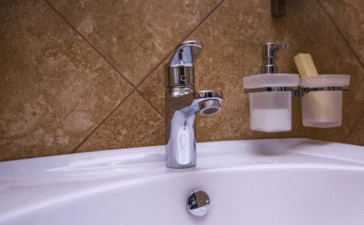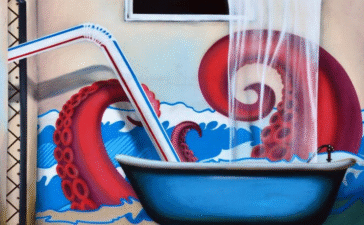Choosing the right bathroom flooring is one of the most critical decisions you’ll make during a remodel. It sets the foundation for the room’s entire aesthetic and must withstand daily challenges like moisture, foot traffic, and humidity. The right floor can transform a purely functional space into a personal sanctuary, tying together all design elements for a cohesive look. Industry leaders, from interior designers to flooring experts, consistently emphasize that the ideal bathroom floor marries beauty with practicality. As we look toward emerging trends, it’s clear that homeowners are seeking materials that offer durability without sacrificing style. This guide will explore the best bathroom floor ideas, providing expert insights to help you select a floor that is safe, stylish, and built to last. We’ll cover everything from top materials and trending patterns to maintenance tips, ensuring your choice enhances your home for years to come.
Why Bathroom Flooring is Crucial for Your Home
The significance of bathroom flooring extends far beyond its appearance. Given the bathroom’s unique environment, functionality is paramount. Selecting moisture-resistant and slip-resistant flooring options is a non-negotiable for safety. A wet floor can be a hazard, so materials with inherent texture or certified slip resistance provide essential peace of mind, especially in homes with children or elderly residents.
Beyond safety, the bathroom floor plays a vital role in creating a cohesive interior design. It should complement the vanity, fixtures, and wall colors while also aligning with the overall style of your home. A well-chosen floor acts as an anchor, grounding the room’s design and creating a seamless transition from other living areas. Durability is another key factor; your flooring choice must be able to endure the constant exposure to water and cleaning products to maintain its integrity and appeal over time.
Top Materials for Bathroom Floors
Expert opinions consistently point toward a few standout materials that offer the best combination of durability, water resistance, and aesthetic versatility for bathroom environments.
Porcelain and Ceramic Tiles
Porcelain and ceramic tiles remain a top choice for bathroom flooring, and for good reason. Their primary advantage is exceptional water resistance, as the glazed surface is virtually impervious to moisture. This makes them one of the most durable bathroom tile options available. They are also incredibly easy to maintain, requiring only regular sweeping and mopping to keep them looking pristine. With an extensive range of designs, colors, and sizes, water-resistant bathroom tiles can suit any style, from modern minimalist to classic traditional.
Luxury Vinyl Flooring (LVT)
Luxury vinyl flooring, often referred to as LVT, has surged in popularity as a cost-effective yet stylish alternative. Modern LVT realistically mimics the appearance of natural materials like hardwood and stone, offering a high-end look without the high-end price tag. These waterproof vinyl floors are comfortable underfoot and less prone to cracking than tile. For homeowners seeking affordable bathroom flooring that doesn’t compromise on aesthetics, luxury vinyl tiles provide an excellent solution that is both durable and easy to install.
Natural Stone
For a touch of unparalleled luxury, natural stone bathroom flooring is an exquisite choice. Materials like marble, slate, and travertine bring organic beauty and a sense of opulence to any bathroom. Marble bathroom floors are timelessly elegant, while slate offers a more rustic, textured feel. Though stone is highly durable, it is porous and requires regular sealing to protect it from water damage and staining. With proper stone tile durability and maintenance, these floors can last a lifetime, adding significant value to your home.
Engineered Wood
While traditional hardwood is generally unsuitable for bathrooms due to its susceptibility to moisture, engineered wood offers a compelling alternative. Constructed with a multi-layer core that resists warping and a real wood veneer on top, these moisture-resistant wood floors bring natural warmth to the bathroom. For those who love a wood-look bathroom flooring aesthetic but need a more practical solution, engineered wood provides the perfect blend of form and function.
Trending Bathroom Floor Patterns and Layouts
The way tiles are laid can have as much impact as the material itself. Design experts are highlighting several floor patterns that are gaining popularity for their ability to add character and visual interest.
Herringbone and Chevron Patterns
Herringbone and chevron tile patterns are classic designs that are experiencing a major revival. These elegant layouts create a sense of movement and sophistication, making them suitable for both small and large bathrooms. Herringbone bathroom flooring, with its staggered rectangular tiles, adds dynamic energy, while the clean V-shape of a chevron layout offers a more modern, streamlined look. These classic bathroom flooring designs elevate any space with their timeless appeal.
Geometric and Mosaic Designs
For those looking to make a bold statement, geometric and mosaic bathroom flooring options are ideal. Hexagonal, octagonal, and penny tiles are creating buzz for their ability to inject personality and artistic flair. Geometric bathroom floor tiles can be used to create intricate patterns or a uniform, modern look. Mosaic bathroom flooring offers nearly limitless customization, allowing you to craft a truly unique bathroom tile pattern that reflects your personal style.
Large Format Tiles and Minimalist Trends
In line with the minimalist trend, large format bathroom tiles are becoming increasingly popular. Using larger tiles means fewer grout lines, which creates a clean, uncluttered, and spacious feel. This approach is particularly effective in an open-concept bathroom flooring design, where a seamless look is desired. Minimalist bathroom floor designs often utilize these oversized tiles to achieve a sleek, contemporary aesthetic that is both beautiful and easy to clean.
Choosing the Right Color and Texture for Your Bathroom Floor
Color and texture are fundamental elements that influence the mood and safety of your bathroom. Expert design practices and color psychology can guide you toward the perfect choice.
Neutral and Timeless Colors
Neutral bathroom floor colors like gray, beige, and white are enduringly popular for their versatility. Gray bathroom tiles provide a chic, modern backdrop, while beige bathroom flooring offers a warmer, more traditional feel. These timeless tones complement a wide range of design schemes and fixtures, ensuring your bathroom won’t feel dated in a few years. They also create a calm, serene atmosphere, perfect for a relaxing space.
Warm Earth Tones
There is a growing trend toward warm bathroom flooring to create a cozier, more inviting ambiance. Earth tone bathroom tiles in shades of terracotta, taupe, and honey are gaining traction. These colors evoke a sense of connection to nature and can make a bathroom feel like a warm, rustic retreat. This trend aligns with a broader movement toward biophilic design, which incorporates natural elements into interior spaces.
Textured and Matte Finishes
In terms of texture, matte and honed finishes are highly recommended for bathroom floors. Matte bathroom tiles have a non-reflective surface that provides better slip resistance than glossy tiles, making them a safer choice. These textured bathroom floors also do an excellent job of concealing water spots and smudges, reducing maintenance. Their understated, modern appeal aligns perfectly with contemporary design trends.
Bathroom Floor Ideas for Small Spaces
In compact bathrooms, strategic design choices can make a significant difference. Experts suggest several flooring strategies to create the illusion of a larger area.
Light-Colored Tiles to Open Up Space
One of the most effective small bathroom floor ideas is to use light-colored bathroom tiles. White, cream, and pale gray floors reflect more light, making the room feel brighter and more open. Choosing tiles with a slight sheen can further enhance this effect. This simple trick is a cornerstone of expanding small bathrooms with flooring.
Vertical and Diagonal Tile Layouts
The direction in which you lay your tiles can also manipulate perception. Installing tiles in a vertical tile pattern can draw the eye upward, making the ceiling feel higher. Similarly, a diagonal bathroom flooring layout creates longer lines, which can make a narrow room appear wider. These space-saving bathroom layouts are clever ways to add visual depth without any structural changes.
Large Tiles to Reduce Grout Lines
Using large bathroom tiles in a small space may seem counterintuitive, but it’s a highly effective strategy. Fewer grout lines create a less busy, more unified surface, which the brain perceives as more expansive. This technique contributes to sleek bathroom floor designs and makes the room feel cleaner and more open.
Maintenance and Longevity of Bathroom Floors
Proper care is essential to ensure your bathroom floor remains beautiful and functional for years to come.
Cleaning and Upkeep for Tile and Stone Floors
For ceramic, porcelain, and natural stone floors, regular maintenance is key. Sweeping or vacuuming to remove debris, followed by mopping with a pH-neutral cleaner, is usually sufficient for bathroom tile cleaning. For natural stone, it’s critical to use cleaners specifically designed for stone floor maintenance to avoid etching or damage. Re-sealing stone periodically is necessary to protect its surface and ensure long-lasting bathroom flooring.
Waterproofing and Protection for Vinyl and Wood Floors
To maintain waterproof bathroom flooring like LVT, simply sweep and mop with a gentle cleaner. Avoid abrasive scrubbers that could scratch the surface. For engineered wood, it’s crucial to wipe up spills immediately. While moisture-resistant, standing water can still cause damage. Using protective coatings for wood floors as recommended by the manufacturer can enhance their durability and longevity.
Also Check: “corner bathroom cabinet“
Final Tips for Choosing the Perfect Bathroom Floor
Selecting the perfect bathroom floor involves balancing aesthetics, functionality, and budget. Start by defining your style and considering how the flooring will integrate with the rest of your home. Always prioritize water and slip resistance for safety and durability. Request samples to see how different materials and colors look in your bathroom’s specific lighting. By combining these expert tips with your personal preferences, you can confidently choose the best bathroom flooring that you’ll love for years to come.
Frequently Asked Questions
What is the most popular flooring for bathrooms?
Porcelain and ceramic tiles remain the most popular choice for bathroom flooring due to their excellent water resistance, durability, and wide variety of styles. Luxury vinyl tile (LVT) is also quickly gaining popularity as a cost-effective, waterproof, and stylish alternative.
What is the best flooring for a small bathroom to make it look bigger?
To make a small bathroom look bigger, use large format tiles in a light, neutral color like white or pale gray. Fewer grout lines create a more seamless, expansive appearance. Laying tiles in a diagonal or vertical pattern can also create visual interest and the illusion of more space.
Is vinyl flooring a good option for bathrooms?
Yes, luxury vinyl flooring (LVT or LVP) is an excellent option for bathrooms. It is 100% waterproof, making it impervious to moisture and spills. It’s also durable, affordable, comfortable underfoot, and available in a wide range of designs that realistically mimic wood and stone.
What flooring is completely waterproof?
Porcelain tile, ceramic tile, and luxury vinyl tile (LVT) are all considered completely waterproof, making them ideal choices for bathrooms and other wet areas. Sheet vinyl is another fully waterproof option.
How can I make my bathroom floor less slippery?
To make your bathroom floor less slippery, choose flooring with a textured or matte finish. Look for tiles with a high coefficient of friction (COF) rating, which indicates better slip resistance. Using smaller tiles, which means more grout lines, can also provide additional traction. Anti-slip treatments are also available for existing tile floors.
Are wood floors a bad idea in a bathroom?
Solid hardwood floors are generally not recommended for full bathrooms because they are highly susceptible to water damage, warping, and mold. However, engineered wood flooring, which is designed for better moisture resistance, can be a suitable alternative for those who want a natural wood look. It’s best used in half-baths or powder rooms with less humidity.












